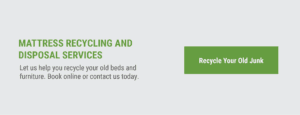What is mattress recycling?
Mattress recycling is the process of dismantling a bed for reuse and recovery. The materials inside a bed are separated, sorted, and then sent to factories for re-manufacturing. The mattress recycling process eliminates landfill waste caused by the dumping of old beds. They’re becoming an essential service for today’s modern cities.
History of Mattress Recycling
Before mattress recyclers, mattresses were dumped in landfills or donated to charities for reuse. There wasn’t a lot of places mattresses could go until recycling companies opened their doors. However, when companies started mattress recycling services, they still shipped many beds and parts of beds overseas for end-markets. Other times, these companies acted as intermediaries, collecting and sending mattresses to the US for disposal and recycling. Only when Canadian entrepreneurs launched dedicated mattress recyclers were these beds recycled at home, reducing transportation costs and CO2 emissions.
In the 2010s, cities such as Vancouver set a levy for mattresses dumped at landfills to offset the disposal cost. This levy encouraged businesses and residents to take their clean or gently used mattresses to recyclers instead. This way, the only beds that end up in landfills are ones contaminated by bed bugs, mould, or are soaked through with water. In part, because of the levy, mattress recyclers can finally compete on the market.
The first mattress recycler in BC opened their doors in 2008. Several years later, Terryl Plotkinoff launched Canadian Mattress Recycling, a dedicated facility on Annacis Island serving Vancouver and the Lower Mainland. Since then, several other mattress recyclers have opened their doors across Canada, including Re-Matt in Calgary, Mother Earth Recycling in Winnipeg, and Ellice Recycle in Victoria, BC.
Mattress Recycling in British Columbia
In BC alone, mattress recyclers provides over 46 jobs for residents. In Metro Vancouver’s report prepared by Morrison Hershfield titled “ Assessment of Economic and Environmental Impacts of Mattress Recycling in BC”, a reported $300,000 worth of recovered materials are generated each year for the end-market by mattress recyclers (2017). The same report notes that recyclers save landfills close to $500,000 a year in operation costs.
Another way mattress recyclers support local cities is by reducing illegally dumped items. Illegally dumped mattresses cost cities approximately $50/unit to pick up and remove. It wastes over $5 million dollars of taxpayer money each year in BC.
However, cities with mattress recyclers often report lower rates of illegal dumping. Affordable recycling rates and accessible hours and services encourage residents to dispose of their mattresses responsibly.

Mattress Recycling Programs
Since then, mattress recycling has grown to support a niche industry worth over $1 million across Canada. BC’s mattress recycling industry alone generates between $300,000 to $500,000 a year, depending on residential and commercial disposal volumes. Some factors include the growing environmental movement across the country and commercial marketing by mattress suppliers such as IKEA and Sleep Country (Source: Morrison Hershfield, 2017).
Mattress recycling serves as a necessary service in today’s cities. Mattress recyclers provide a service linking manufacturers with end-markets and offers an alternative to traditional disposal methods.
Mattress Recycling Intermediaries
Mattress recyclers not only deal with residents and commercial businesses. Junk removal companies and independent junk removers also benefit from mattress recyclers. Acting as intermediaries, these companies send mattresses they collect to the recycler, often paying a special rate only available at these companies. In Metro Vancouver, companies routinely deliver old mattresses to Canadian Mattress Recycling.
Conclusion
Mattress recycling is a growing niche industry within the waste management sector. Although a difficult industry to enter with high operation costs and the need for specialized knowledge, several mattresses recyclers have flourished across Canada. One of these, Canadian Mattress Recycling, has been operating in Vancouver and the Lower Mainland for almost a decade. They alone provide an essential service for residents and businesses. In an age where environmental sustainability is important, and climate change is the biggest challenge of the century, residents and businesses are beginning to see mattress recycling as a necessary service.





